Ignacio Merino
Ignacio Merino Muñoz (30 January 1817–17 March 1876) was a Peruvian painter notable for historical and costumbrista works, and considered the founder of the Peruvian school of painting.[1][2] Beginning at age 6, he spent much of his life in Paris.[3]
Ignacio Merino | |
|---|---|
_(cropped).jpg.webp) Merino photographed c. 1860 | |
| Known for | Founding the Peruvian school of art |
| Style | History painting, costumbrista, academic art |
His artworks inspired French writer Jules Verne's 1852 short story "Martin Paz," which was set in Lima, Peru and begins with a summarization of Merino's life and art.[1][3]
Biography
Early life in Peru
Ignacio Merino Muñoz was born on January 30, 1817 in Piura, Peru. His mother Doña Micaela María Muñoz, was from a wealthy aristocratic family in Trujillo, descending from maternal ancestry in both Spanish and Peruvian nobility. His father, Don José Clemente Merino, was a judge, district administrator and military commander.[3] As a toddler on the beach, Muñoz would draw the contour outline of sailing ships in the sand, exhibiting skill in observational drawing.[3] By the age of four, he was creating fine art on paper and seemed absorbed in its process, which impressed his mother; she expressed hope that Muñoz would be the first Peruvian fine artist.[3]
First trip to Paris
Circa 1827, shortly after reaching 6 years of age, his parents allowed Muñoz to travel to Paris for an arts education, though they chose not to accompany him.[3] There, Muñoz attended high school, earned his bachelor's degree in law, and pursued his art career.[3] In Paris, Muñoz studied under French painters Raymond Monvoisin and Paul Delaroche, who inspired his interest in history painting. As a result of Delaroche's influence, Muñoz focused on themes from European history, whereas his Peruvian-themed paintings were generally in the costumbrista category.[4]
Educating in Peru
In 1838, Muñoz returned to Peru at 20 years of age, also having studied in Italy and Spain.[3] Upon his return, he established a school of lithography and a school of drawing and paint.[3] He became Assistant Director, then Director of the "Academy of Drawing and Painting," founded by José Fernando de Abascal, where he taught or otherwise influenced the careers of other prominent painters, such as Luis Montero, Francisco Masías and Francisco Laso.[5]
During the 1840s, he created a series of portraits devoted to Peruvian saints, including Rose of Lima and Martín de Porres.
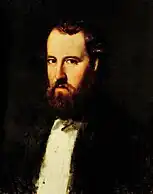
.jpg.webp)
Return to Paris
In 1850, he had an opportunity to study with Eugène Delacroix, and returned to Paris. He would remain there for the rest of his life. It is said that an exhibition of his costumbrista paintings served as the inspiration for Martin Paz, an adventure story by Jules Verne, which was set in Lima.[6] Upon returning to Paris, he produced 92 wood engravings for a luxury 1854 edition of Esteban Terralla y Landa's 1797 satire Lima por dentro y fuera, collaborating with Parisian printer A. Mézin and draftsman A. Jourdain.[7] Many of these engravings, including landscapes, portraits, and popular scenes, served as studies for later canvases of costumbrista themes.[7]
It was there he created his best-known painting, Colón ante los doctores en Salamanca, which was purchased by the government of President José Balta after winning a third-place medal at the "Exposition des Beaux-Arts". He was also inspired by European literature and created works based on the writings of Shakespeare, Sir Walter Scott and Miguel de Cervantes.[5]
Death and legacy


Muñoz died of tuberculosis in 1876, and he was buried in Père Lachaise Cemetery. Having never married and without an heir, he ceded his estate and artworks to the Municipality of Lima.
This included 33 paintings which, in 1925, were the first acquisitions of the newly founded Ignacio Merino Municipal Art Gallery, which continues to operate as of 2023.[8]
Gallery
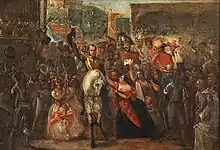 The Entry of President Luis José de Orbegoso to Lima, ca. 1842
The Entry of President Luis José de Orbegoso to Lima, ca. 1842.jpg.webp) Frutera, 1850
Frutera, 1850 La Jarana (lit. The Revelry), c. 1857
La Jarana (lit. The Revelry), c. 1857 Reading Don Quixote, 1861
Reading Don Quixote, 1861
 Portrait of an Old Man, unknown date
Portrait of an Old Man, unknown date Italian Courtship, unknown date
Italian Courtship, unknown date Pizarro Taking Possession of the Pacific in the Name of the Kings of Spain, c. 1850
Pizarro Taking Possession of the Pacific in the Name of the Kings of Spain, c. 1850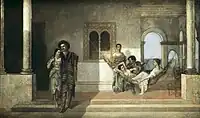 American Scene (Scenes from the Life of Andalusia), c. 1854
American Scene (Scenes from the Life of Andalusia), c. 1854 Portrait of Francisco Masías, 1855
Portrait of Francisco Masías, 1855 Woman Giving Alms, unknown date
Woman Giving Alms, unknown date Christopher Columbus and His Son Lodged in the Convent of La Rábida, 1855
Christopher Columbus and His Son Lodged in the Convent of La Rábida, 1855 The Turk, unknown date
The Turk, unknown date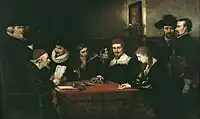 The Opening of the Will, 1864
The Opening of the Will, 1864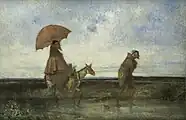 The Friars Crossing a Ford, c. 1865
The Friars Crossing a Ford, c. 1865 Appearance of the Angel to the Family of Tobias, c. 1867
Appearance of the Angel to the Family of Tobias, c. 1867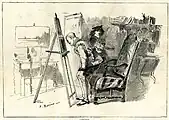 The Aficionado, 1868
The Aficionado, 1868 The Revenge of Mr. Cornaro, 1869
The Revenge of Mr. Cornaro, 1869 The Woman Who Laughs (The Crazy), c. 1870
The Woman Who Laughs (The Crazy), c. 1870 A Jester (Mephistopheles), 1870
A Jester (Mephistopheles), 1870.jpg.webp) Hamlet, 1872
Hamlet, 1872 On the Boat, c. 1874
On the Boat, c. 1874
References
- cultural, Hermeneuta Revista (2022-03-17). "Ignacio Merino, el pintor peruano que inspiró a Julio Verne en sus inicios como novelista". Hermeneuta. Revista cultural (in Spanish). Retrieved 2023-08-10.
- "Ignacio Merino. Fundador de la escuela peruana". afapperu (in Spanish). Retrieved 2023-08-10.
- Verne, Jules (1876). Martín Paz: los primeros navíos mejicanos (in Spanish). Creative Media Partners, LLC. ISBN 978-0-341-13121-2.
- Museo de Arte de Lima Ignacio Merino: La Historia Imaginada
- Brief biography @ Biografías y Vidas
- "Ignacio Merino: La Historia Imaginada Archived 2016-03-05 at the Wayback Machine @ Peru 21.
- Zavalza Hough-Snee, Dexter (2015). Estudios de sátira hispanoamericana. Madrid: Iberoamericana/Vervuert. pp. 87–119. ISBN 9788484898689.
- Summer, Eva (2021-03-01). "Municipal Art Gallery Ignacio Merino". LimaEasy. Retrieved 2023-08-10.
Further reading
- Juan Bautista de Lavalle, Ignacio Merino, 1817-1917: biografía del pintor, Casa Editora M. Moral, 1917
- Juan Manuel Ugarte Eléspuru, "Ignacio Merino", Volume 33 of Biblioteca Hombres del Perú, Editorial Universitaria, 1966
- Dexter Zavalza Hough-Snee, "Ilustrando la república a través de la sátira colonial: Ignacio Merino y la reconfiguración de Lima por dentro y fuera." Estudios de sátira hispanoamericana. eds. Zavalza & Eduardo Viana da Silva. Madrid: Iberoamericana/Vervuert, 2015. pp. 87–119.